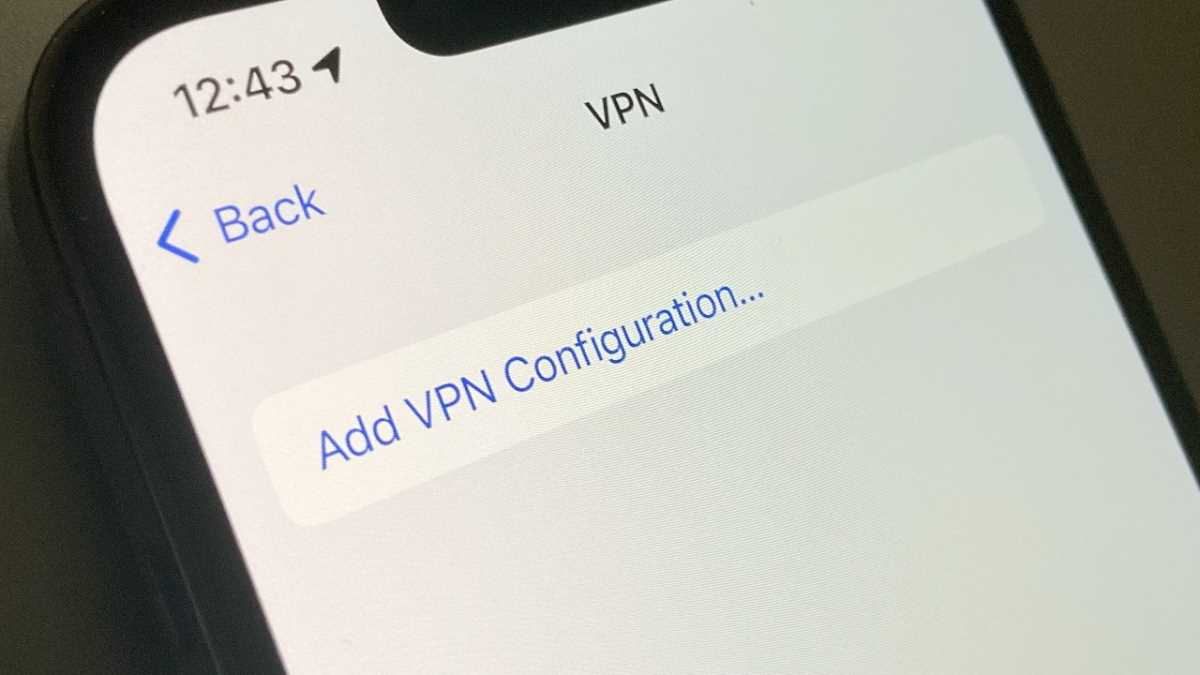Home>Software and Apps>What Is Site To Site VPN


Software and Apps
What Is Site To Site VPN
Published: March 5, 2024
Learn about site-to-site VPN and how it enables secure communication between networks. Explore the best software and apps for setting up site-to-site VPN connections.
(Many of the links in this article redirect to a specific reviewed product. Your purchase of these products through affiliate links helps to generate commission for Techsplurge.com, at no extra cost. Learn more)
Table of Contents
Introduction
In today's interconnected digital landscape, the need for secure and reliable communication between geographically dispersed networks is paramount. This is where Site-to-Site Virtual Private Network (VPN) technology comes into play. Site-to-Site VPN serves as a secure conduit for transmitting and receiving data between multiple locations, providing a seamless and encrypted connection over the public internet.
As organizations expand their operations across different geographical locations, the demand for secure and efficient communication channels becomes increasingly crucial. Site-to-Site VPN offers a robust solution to this challenge, enabling businesses to establish secure and private network connections between their various sites, regardless of the physical distance between them.
By leveraging Site-to-Site VPN, organizations can ensure that their sensitive data and communications remain shielded from unauthorized access and potential security threats. This technology facilitates the establishment of a virtual network that extends across different physical locations, allowing for seamless and secure data exchange.
In the subsequent sections, we will delve deeper into the intricacies of Site-to-Site VPN, exploring its functionalities, benefits, working mechanisms, different types, setup procedures, and essential considerations for successful implementation. Understanding these aspects will provide a comprehensive insight into the significance of Site-to-Site VPN in modern networking infrastructures and the pivotal role it plays in ensuring secure and efficient inter-site communication.
Read more: What Is A VPN On A Phone
Understanding Site To Site VPN
Site-to-Site VPN, also known as router-to-router VPN, is a technology that enables the secure connection of multiple networks across different locations. It establishes a virtual bridge between these networks, allowing seamless and encrypted communication over the public internet. Unlike traditional VPNs that cater to individual users, Site-to-Site VPN is designed to facilitate secure data transmission between entire networks, making it an essential tool for organizations with geographically dispersed offices or branches.
At its core, Site-to-Site VPN functions as a secure tunnel that extends the reach of a private network across disparate locations. This is achieved by encrypting the data packets transmitted between the connected networks, thereby safeguarding sensitive information from unauthorized access or interception. By leveraging robust encryption protocols and authentication mechanisms, Site-to-Site VPN ensures that data traversing the virtual tunnel remains confidential and integral throughout the transmission process.
One of the fundamental aspects of Site-to-Site VPN is its ability to emulate a direct physical connection between the interconnected networks. This means that devices within each network can communicate with one another as if they were all part of the same local area network (LAN). This seamless integration fosters efficient collaboration and resource sharing across geographically dispersed sites, enhancing overall productivity and operational cohesion within the organization.
Furthermore, Site-to-Site VPN offers a scalable and cost-effective solution for interconnecting multiple sites without the need for dedicated leased lines or expensive hardware. This makes it an attractive option for businesses seeking to establish secure and reliable network connectivity between their various locations while minimizing infrastructure costs.
In essence, Site-to-Site VPN serves as a cornerstone of modern enterprise networking, empowering organizations to transcend geographical barriers and create a unified, secure, and interconnected network infrastructure. Its ability to ensure the confidentiality, integrity, and availability of data transmissions between geographically dispersed networks makes it an indispensable tool for businesses striving to maintain a secure and efficient communication framework across their distributed operations.
Benefits of Site To Site VPN
Site-to-Site VPN offers a myriad of benefits that are instrumental in addressing the communication and security needs of modern organizations with geographically dispersed operations. These benefits include:
-
Enhanced Security: Site-to-Site VPN employs robust encryption protocols to secure data transmissions between interconnected networks. By encrypting the traffic traversing the virtual tunnel, it ensures that sensitive information remains shielded from unauthorized access and potential security breaches. This heightened level of security is crucial for safeguarding sensitive business data, customer information, and proprietary communications from external threats.
-
Cost-Efficiency: Unlike traditional networking solutions that rely on dedicated leased lines or expensive hardware, Site-to-Site VPN offers a cost-effective alternative for establishing secure inter-site connectivity. By leveraging the public internet as the communication medium, organizations can significantly reduce infrastructure costs while maintaining a high level of security and reliability across their interconnected networks.
-
Scalability: Site-to-Site VPN provides a scalable solution for connecting multiple sites, allowing organizations to expand their network infrastructure without the constraints of physical proximity. Whether adding new branch offices or integrating remote facilities into the network, Site-to-Site VPN accommodates the evolving connectivity needs of businesses, offering a flexible and scalable approach to network expansion.
-
Seamless Integration: By emulating a direct physical connection between interconnected networks, Site-to-Site VPN facilitates seamless integration of disparate locations into a unified network infrastructure. This enables efficient collaboration, resource sharing, and centralized access to network resources across geographically dispersed sites, fostering operational cohesion and productivity within the organization.
-
Remote Access: Site-to-Site VPN enables remote access to centralized resources and services, allowing employees at different locations to securely access shared applications, databases, and internal systems. This remote accessibility enhances workforce mobility and facilitates seamless collaboration, irrespective of the physical distance between the users and the network resources.
-
Reliability: Site-to-Site VPN ensures reliable and consistent connectivity between interconnected networks, mitigating the risks associated with network downtime or disruptions. By establishing a secure and resilient communication channel, organizations can maintain uninterrupted access to critical resources and applications across their distributed operations, thereby enhancing overall operational continuity.
In summary, the benefits of Site-to-Site VPN encompass enhanced security, cost-efficiency, scalability, seamless integration, remote accessibility, and reliability. These advantages collectively contribute to the establishment of a secure, interconnected, and efficient network infrastructure that caters to the evolving communication needs of modern organizations with geographically dispersed operations.
How Site To Site VPN Works
Site-to-Site VPN operates by establishing a secure and encrypted connection between the local area networks (LANs) of different sites, enabling seamless and protected data transmission across geographically dispersed locations. The underlying mechanism of Site-to-Site VPN involves the encapsulation of data packets within encrypted tunnels, which are transmitted over the public internet. This process ensures that sensitive information remains confidential and integral throughout its journey between the interconnected networks.
At the core of Site-to-Site VPN functionality are the VPN gateways or routers deployed at each site. These gateways serve as the entry and exit points for the encrypted traffic, encapsulating outgoing data packets and decrypting incoming packets. By leveraging robust encryption algorithms and authentication protocols, the VPN gateways establish a secure communication channel, effectively extending the reach of the private network across disparate locations.
When data is transmitted from one site to another, it is encapsulated within encrypted packets, which are then transmitted over the public internet. Upon reaching the destination site, the receiving VPN gateway decrypts the packets, allowing the original data to be retrieved and forwarded to the intended destination within the local network. This entire process occurs seamlessly and transparently to the end users, enabling secure and efficient communication between the interconnected sites.
The encryption protocols utilized in Site-to-Site VPN, such as IPsec (Internet Protocol Security) and SSL/TLS (Secure Sockets Layer/Transport Layer Security), play a pivotal role in ensuring the confidentiality and integrity of data transmissions. These protocols employ advanced encryption algorithms and cryptographic techniques to secure the data packets, rendering them indecipherable to unauthorized entities attempting to intercept or eavesdrop on the communication channel.
Moreover, the authentication mechanisms integrated into Site-to-Site VPN gateways validate the identities of the communicating networks, ensuring that only authorized parties can establish and maintain the secure connection. This authentication process adds an additional layer of security, mitigating the risks associated with unauthorized access and potential intrusions into the interconnected networks.
In essence, Site-to-Site VPN works by creating a secure and virtual bridge between geographically dispersed LANs, enabling the seamless and encrypted transmission of data across different sites. By leveraging robust encryption and authentication mechanisms, Site-to-Site VPN ensures that sensitive information remains protected from unauthorized access and interception, thereby fostering secure and efficient communication between interconnected networks.
Types of Site To Site VPN
Site-to-Site VPN technology encompasses various types, each offering distinct functionalities and deployment approaches tailored to the specific requirements of organizations. Understanding the different types of Site-to-Site VPN is crucial for selecting the most suitable solution that aligns with the unique networking needs and security considerations of businesses. The primary types of Site-to-Site VPN include:
-
Intranet-based Site-to-Site VPN: This type of VPN is designed to establish secure connections between the LANs of different sites within the same organization. Intranet-based Site-to-Site VPNs facilitate private and encrypted communication between internal networks, ensuring that sensitive data remains shielded from external threats. By leveraging this type of VPN, organizations can create a unified and secure network infrastructure across their various locations, fostering seamless collaboration and resource sharing.
-
Extranet-based Site-to-Site VPN: Extranet-based VPNs extend the concept of Intranet-based VPNs to include secure connections between the networks of different organizations or business partners. This type of VPN enables secure inter-organizational communication, allowing authorized entities to establish encrypted connections for the exchange of sensitive data and collaborative initiatives. Extranet-based Site-to-Site VPNs play a pivotal role in facilitating secure and controlled communication channels between external entities, enhancing collaboration and data sharing while maintaining stringent security measures.
-
Hub-and-Spoke Site-to-Site VPN: In the Hub-and-Spoke VPN architecture, a central hub site serves as the focal point for connecting multiple remote spoke sites. This configuration enables efficient and centralized communication between the hub site and the interconnected spokes, streamlining data exchange and resource accessibility across the network. Hub-and-Spoke Site-to-Site VPNs offer a scalable and structured approach to interconnecting multiple sites, providing a centralized hub for managing and orchestrating secure communication channels with remote locations.
-
Full Mesh Site-to-Site VPN: Full Mesh VPN architecture establishes direct and secure connections between all sites within a network, creating a comprehensive mesh of interconnected VPN tunnels. This type of VPN configuration fosters direct communication paths between every site, enabling seamless and decentralized data transmission across the entire network. Full Mesh Site-to-Site VPNs offer enhanced redundancy and flexibility, allowing for direct communication between any pair of interconnected sites, thereby optimizing data exchange and network resilience.
By comprehensively understanding the distinct types of Site-to-Site VPN and their respective functionalities, organizations can make informed decisions regarding the selection and deployment of the most suitable VPN solution that aligns with their specific networking requirements and security objectives. Each type of Site-to-Site VPN offers unique advantages and considerations, empowering businesses to establish secure and efficient communication channels across their geographically dispersed operations.
Read more: What Is Chromecast
Setting Up a Site To Site VPN
Setting up a Site-to-Site VPN involves a series of strategic steps aimed at establishing secure and seamless connectivity between multiple geographically dispersed networks. The process encompasses meticulous planning, configuration of VPN gateways, and adherence to best practices to ensure the successful implementation of the VPN infrastructure.
-
Network Assessment: The initial step in setting up a Site-to-Site VPN involves conducting a comprehensive assessment of the existing network infrastructure. This assessment entails identifying the various sites that require interconnection, evaluating the network topology, and determining the specific connectivity requirements of each site. By gaining a holistic understanding of the network landscape, organizations can formulate an effective strategy for deploying the Site-to-Site VPN.
-
VPN Gateway Configuration: The next crucial phase involves configuring the VPN gateways deployed at each site. This entails defining the encryption protocols, authentication mechanisms, and security parameters to be employed within the VPN tunnels. Additionally, the VPN gateways need to be configured to establish secure communication channels, ensuring that data transmissions are encrypted and authenticated in accordance with the organization's security policies.
-
IP Address Assignment: Assigning unique and non-overlapping IP addresses to the interconnected networks is essential for seamless communication within the Site-to-Site VPN infrastructure. This involves defining the IP address ranges for each site and ensuring that they do not conflict with the addressing schemes of other interconnected networks. Proper IP address assignment is critical for preventing routing issues and ensuring efficient data exchange between the interconnected sites.
-
Tunnel Establishment: Once the VPN gateways are configured and the IP addresses are assigned, the next step involves establishing the VPN tunnels between the interconnected sites. This process involves initiating the secure connections, verifying the integrity of the VPN tunnels, and ensuring that the encrypted communication channels are operational and resilient.
-
Testing and Validation: After the VPN tunnels are established, rigorous testing and validation procedures are conducted to verify the functionality and security of the Site-to-Site VPN. This includes performing connectivity tests, data transmission assessments, and security audits to ensure that the VPN infrastructure operates as intended and complies with the organization's security standards.
-
Monitoring and Maintenance: Upon successful deployment, continuous monitoring and maintenance of the Site-to-Site VPN infrastructure are imperative to ensure its ongoing performance and security. This involves implementing monitoring tools to track the status of the VPN tunnels, conducting regular security audits, and promptly addressing any potential issues or vulnerabilities that may arise.
By meticulously following these steps and adhering to best practices, organizations can effectively set up a Site-to-Site VPN that provides secure, reliable, and seamless connectivity between their geographically dispersed networks. This enables the establishment of a unified and secure network infrastructure, fostering efficient communication and resource sharing across diverse locations.
Considerations for Site To Site VPN Implementation
Implementing a Site-to-Site VPN requires careful consideration of various factors to ensure the successful deployment and optimal functionality of the VPN infrastructure. The following considerations are pivotal in guiding organizations through the implementation process:
-
Security Protocols and Encryption: Selecting the appropriate security protocols and encryption algorithms is critical for safeguarding data transmissions within the Site-to-Site VPN. Organizations must evaluate the security requirements of their interconnected networks and choose encryption standards that align with their security policies and compliance mandates. Robust encryption protocols, such as IPsec and SSL/TLS, should be implemented to ensure the confidentiality and integrity of data traversing the VPN tunnels.
-
Scalability and Flexibility: Organizations should assess the scalability and flexibility of the chosen Site-to-Site VPN solution to accommodate future network expansion and evolving connectivity needs. The VPN infrastructure should be designed to seamlessly integrate new sites and adapt to changes in network topology, ensuring that it can scale to meet the organization's growing interconnection requirements without compromising performance or security.
-
Network Performance and Bandwidth: Evaluating the network performance and bandwidth requirements of interconnected sites is essential for optimizing the data transmission capabilities of the Site-to-Site VPN. Organizations must consider factors such as latency, throughput, and Quality of Service (QoS) to ensure that the VPN infrastructure can efficiently handle the volume of data traffic between sites while maintaining consistent performance levels.
-
Redundancy and High Availability: Implementing redundancy and high availability mechanisms within the Site-to-Site VPN infrastructure is crucial for mitigating the risks associated with network disruptions and ensuring continuous connectivity between interconnected sites. Deploying redundant VPN gateways, failover configurations, and resilient network paths enhances the reliability and fault tolerance of the VPN infrastructure, minimizing the impact of potential network outages.
-
Compliance and Regulatory Requirements: Organizations operating within regulated industries must consider compliance and regulatory requirements when implementing a Site-to-Site VPN. Ensuring that the VPN infrastructure adheres to industry-specific security standards, data protection regulations, and privacy laws is imperative for maintaining legal and regulatory compliance while safeguarding sensitive information transmitted across interconnected networks.
-
Monitoring and Management: Establishing robust monitoring and management capabilities is essential for overseeing the performance, security, and operational status of the Site-to-Site VPN. Implementing network monitoring tools, logging mechanisms, and centralized management platforms enables organizations to proactively identify and address potential issues, track VPN usage, and enforce security policies across interconnected sites.
By meticulously addressing these considerations, organizations can navigate the complexities of Site-to-Site VPN implementation and establish a secure, scalable, and resilient network infrastructure that facilitates seamless communication and data exchange between their geographically dispersed locations. These considerations form the foundation for a comprehensive and strategic approach to deploying a Site-to-Site VPN that aligns with the specific networking requirements and security objectives of modern organizations.
Conclusion
In conclusion, Site-to-Site VPN technology stands as a cornerstone of modern networking infrastructures, offering a secure, efficient, and scalable solution for interconnecting geographically dispersed networks. The significance of Site-to-Site VPN lies in its ability to establish virtual bridges between disparate locations, fostering seamless and encrypted communication while ensuring the confidentiality, integrity, and availability of data transmissions.
By leveraging Site-to-Site VPN, organizations can transcend geographical barriers and create a unified network infrastructure that facilitates secure collaboration, resource sharing, and centralized access to network resources across diverse locations. The benefits of Site-to-Site VPN, including enhanced security, cost-efficiency, scalability, seamless integration, remote accessibility, and reliability, collectively contribute to the establishment of a robust and interconnected network framework that caters to the evolving communication needs of modern businesses.
The diverse types of Site-to-Site VPN, such as Intranet-based, Extranet-based, Hub-and-Spoke, and Full Mesh configurations, offer tailored functionalities to address the specific networking and security requirements of organizations. Understanding these types empowers businesses to select the most suitable VPN solution that aligns with their unique operational and connectivity needs.
The process of setting up a Site-to-Site VPN involves meticulous planning, configuration of VPN gateways, IP address assignment, tunnel establishment, testing, and ongoing monitoring and maintenance. By adhering to best practices and strategic implementation steps, organizations can ensure the successful deployment of a secure and seamless VPN infrastructure that facilitates efficient communication and resource sharing across their distributed operations.
Furthermore, considerations such as security protocols and encryption, scalability, network performance, redundancy, compliance, and monitoring play a pivotal role in guiding organizations through the implementation process, enabling them to establish a secure, scalable, and resilient Site-to-Site VPN infrastructure that meets their specific networking and security objectives.
In essence, Site-to-Site VPN technology serves as a fundamental enabler for organizations to establish secure and interconnected network infrastructures, transcending geographical constraints and fostering seamless communication and collaboration across diverse locations. Its role in ensuring the secure transmission of data and the seamless integration of geographically dispersed networks underscores its significance in modern networking environments, making it an indispensable tool for businesses striving to maintain secure and efficient inter-site communication.















